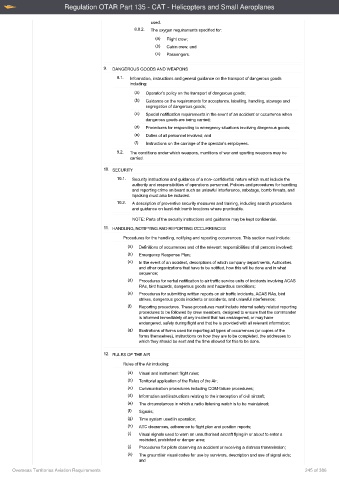Page 245 - Overseas Territories Aviation Requirements Consolidated - Total AOC
P. 245
Regulation OTAR Part 135 - CAT - Helicopters and Small Aeroplanes
used.
8.8.2. The oxygen requirements specified for:
(a) Flight crew;
(b) Cabin crew; and
(c) Passengers.
9. DANGEROUS GOODS AND WEAPONS
9.1. Information, instructions and general guidance on the transport of dangerous goods
including:
(a) Operator’s policy on the transport of dangerous goods;
(b) Guidance on the requirements for acceptance, labelling, handling, stowage and
segregation of dangerous goods;
(c) Special notification requirements in the event of an accident or occurrence when
dangerous goods are being carried;
(d) Procedures for responding to emergency situations involving dangerous goods;
(e) Duties of all personnel involved; and
(f) Instructions on the carriage of the operator’s employees.
9.2. The conditions under which weapons, munitions of war and sporting weapons may be
carried.
10. SECURITY
10.1. Security instructions and guidance of a non- confidential nature which must include the
authority and responsibilities of operations personnel. Policies and procedures for handling
and reporting crime on board such as unlawful interference, sabotage, bomb threats, and
hijacking must also be included.
10.2. A description of preventive security measures and training, including search procedures
and guidance on least-risk bomb locations where practicable.
NOTE: Parts of the security instructions and guidance may be kept confidential.
11. HANDLING, NOTIFYING AND REPORTING OCCURRENCES
Procedures for the handling, notifying and reporting occurrences. This section must include:
(a) Definitions of occurrences and of the relevant responsibilities of all persons involved;
(b) Emergency Response Plan;
(c) In the event of an accident, descriptions of which company departments, Authorities
and other organizations that have to be notified, how this will be done and in what
sequence;
(d) Procedures for verbal notification to air traffic service units of incidents involving ACAS
RAs, bird hazards, dangerous goods and hazardous conditions;
(e) Procedures for submitting written reports on air traffic incidents, ACAS RAs, bird
strikes, dangerous goods incidents or accidents, and unlawful interference;
(f) Reporting procedures. These procedures must include internal safety related reporting
procedures to be followed by crew members, designed to ensure that the commander
is informed immediately of any incident that has endangered, or may have
endangered, safety during flight and that he is provided with all relevant information;
(g) Illustrations of forms used for reporting all types of occurrences (or copies of the
forms themselves), instructions on how they are to be completed, the addresses to
which they should be sent and the time allowed for this to be done.
12. RULES OF THE AIR
Rules of the Air including:
(a) Visual and instrument flight rules;
(b) Territorial application of the Rules of the Air;
(c) Communication procedures including COM-failure procedures;
(d) Information and instructions relating to the interception of civil aircraft;
(e) The circumstances in which a radio listening watch is to be maintained;
(f) Signals;
(g) Time system used in operation;
(h) ATC clearances, adherence to flight plan and position reports;
(i) Visual signals used to warn an unauthorised aircraft flying in or about to enter a
restricted, prohibited or danger area;
(j) Procedures for pilots observing an accident or receiving a distress transmission;
(k) The ground/air visual codes for use by survivors, description and use of signal aids;
and
Overseas Territories Aviation Requirements 245 of 386

